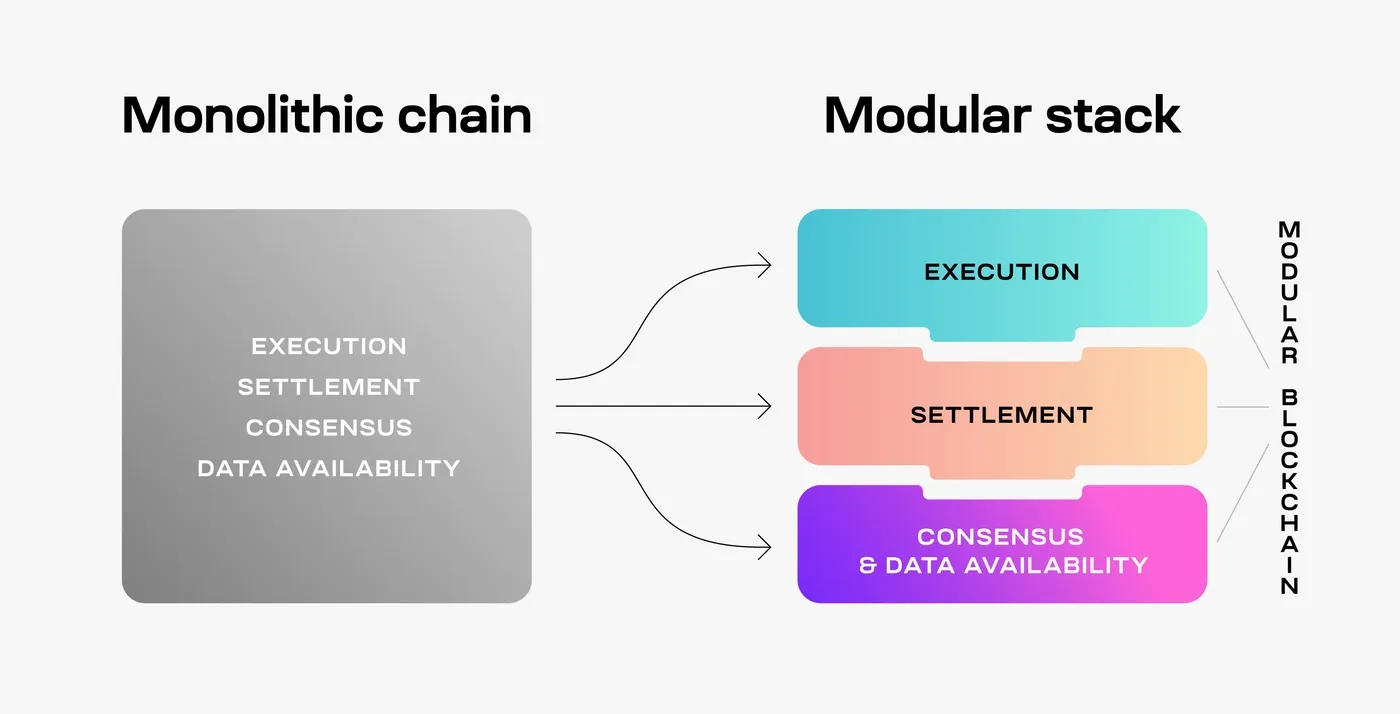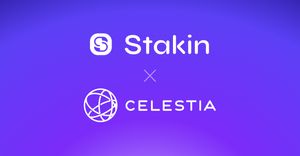The quest for scalability and accessibility in the blockchain world has long been a formidable challenge. Celestia, a pioneering solution that addresses these concerns, announced that it is live on the mainnet beta. This modular data availability network not only provides robust security but also seamlessly adapts to the rapidly growing user base, enabling developers to easily launch blockchain projects of their own.
Stakin's Role on the Celestia Mainnet
It's important to highlight that Stakin has been chosen as one of the selected operators, reinforcing our commitment to blockchain evolution. Stakin's role as a validator not only underscores its commitment to developing blockchain advances but also solidifies its position as a trusted participant in the ecosystem.
Let’s take a closer look at what Celestia is:
In simple words, earlier blockchain systems like Bitcoin and Ethereum used a single-layered architecture. This means every task, from verifying transactions to making them happen, is done in one place. While Ethereum's Layer 2 solutions introduce a degree of modularity by segregating certain tasks to secondary layers, Celestia's modular approach focuses on dividing tasks into specific parts or layers within the network architecture itself.
The Limits of Monolithic Blockchains
Before diving deep into the innovation Celestia brings, it's vital to comprehend the broader landscape. Most existing blockchains are monolithic. These generalist blockchains, adopting the "do everything yourself" approach, have been instrumental in showcasing the diverse application potential of blockchains. Yet, as applications evolved, inherent challenges surfaced:
Restrictions on Development: There's a limit to the kind of applications you can build on a shared blockchain space.
Cost Implications: Elevated fees can render apps unaffordable.
Limited Access: As capacity increases, the affordability for individuals to verify network integrity declines.
These challenges often counteract the very essence of what blockchains promise: accessibility, affordability, and decentralization.
In response to these challenges, a modern solution has emerged: modular blockchains. Unlike monolithic chains, which encompass a wide range of functionalities, modular blockchains, including Celestia, are more specialized. They focus on specific tasks and work collaboratively with other chains to form a comprehensive system, often referred to as a modular stack.
Think of modular blockchains as building blocks, similar to Lego pieces, that can be combined in various configurations to create diverse structures. For example, rollups, which serve as hosts for applications and replicate many features of monolithic blockchains, utilize another network, such as Celestia, to manage tasks that are beyond their capabilities.

The functions that modular blockchains can specialize in are:
Execution: It involves executing transactions that correctly update the state. Thus, execution must ensure that only valid transactions are executed, i.e., transactions resulting in valid state machine transitions.
Settlement: This entails an environment for execution layers to verify proofs, resolve fraud disputes, and bridge between other execution layers.
Consensus entails agreeing on the order of the transactions.
Data Availability (DA) entails making the transaction data available. Note that execution, settlement, and consensus require DA.
Adopting Modularity: Why?
There are several compelling advantages to a modular design:
Autonomy: While it seamlessly collaborates with foundational components, each user/project maintains its own functions.
Efficient Development: By concentrating on particular segments, the process of building blockchains becomes more streamlined.
Scalability & Distributed Control: The modular design inherently facilitates growth. With separate layers and each module, performance is optimized without compromising on decentralized governance.
Celestia's Advanced Data Availability Layer
The Data Availability (DA) layer in Celestia stands out as a solution to a longstanding challenge. In permissionless blockchain networks, ensuring accessible and verifiable transaction data is crucial. Celestia's DA layer introduces innovative features like Data Availability Sampling (DAS) and Namespaced Merkle Trees (NMTs), which collectively accelerate its scalability while ensuring security.
DAS, for instance, permits Celestia's light nodes to confirm data availability without downloading entire blocks. The system's adaptability ensures that as more light nodes come online, the network sustains larger data blocks and higher transaction volumes.
Building on Celestia: A Paradigm of Efficiency
Celestia promises developers an expedited, yet comprehensive experience. Its environment echoes the flexibility of smart contract development, ensuring rapid blockchain deployments, supporting a diverse range of virtual machines, and dynamically scaling as user bases expand.
Rollups in the Celestia Context
Rollups have also gained traction as a solution to ease mainchain transactional data loads. While traditional rollups direct their data to networks like Ethereum, Celestia's approach is distinct. By channeling transaction data to its own network, Celestia's rollups leverage its formidable data availability and security mechanisms
Ethereum currently (although this was not always so) envisions its end-state of scalability predominantly through rollups. Rollups are a Layer 2 solution where computation occurs off-chain, and only the resulting data is submitted to the main Ethereum chain. This process significantly reduces network load on layer-1, thereby allowing a higher scale of user activity even with the L1 remaining relatively static, i.e. with minimal necessary modifications to the consensus mechanism.
Various blockchains have adopted other approaches to scaling. Solana envisions all activity happening directly on the base layer, at scale with no need for layer 2 solutions. Both Aptos and Sui leverage the Move programming language and a parallel execution engine for scalability. NEAR uses sharding with its Nightshade technology, dividing the blockchain into "shards" for parallel processing of transactions and smart contracts. Kaspa utilizes the GHOSTDAG protocol, notably not a PoS system.
Going back to Ethereum's vision to scale via L2s, we can appreciate the purpose of Celestia within this ecosystem. Celestia is designed to fulfill a crucial role for rollups: providing data availability. By ensuring data availability, Celestia supports the integrity and functionality of rollups, ultimately contributing to the broader goal of blockchain scalability.
Final Thoughts
Celestia is carving a unique path with its innovative modular data network, addressing some long-standing challenges in the blockchain industry. A standout in its suite of features is Data Availability Sampling (DAS). This isn't just a fancy term; it's an inventive solution that ensures the system can scale up, handling a surge in data, all the while maintaining its core promises of security and accessibility. It's a clear reflection of Celestia's commitment to crafting practical and forward-thinking solutions for real-world challenges.
With the combined strengths of Celestia's innovative approach and our experience, we're optimistic about creating a more robust, user-centric, and adaptable blockchain ecosystem for everyone.
About Stakin
Stakin is an infrastructure operator for Proof-of-Stake (PoS) blockchains offering secure, reliable, and non-custodial staking services. The company enables cryptocurrency holders to earn interest on their assets and take part in decentralized governance while remaining in possession of their own cryptocurrencies.
Stakin serves institutional crypto players, foundations, custodians, exchanges as well as a large community of individual token holders. Driven by demand from institutional customers and the community, Stakin provides services for a wide range of networks including leading ecosystems such as Ethereum, Cosmos, Solana, Near, Polygon, Polkadot, Aptos, Sui, and more.
For more information about Stakin, visit the Website, Twitter, Blog, or join the Telegram community.


Join the conversation